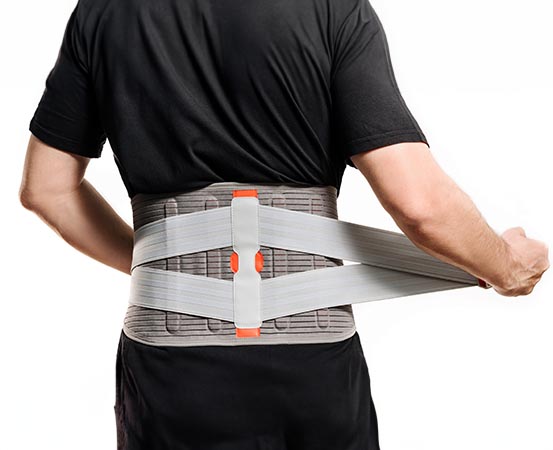
People with desk jobs, working seated for hours at a stretch, have an increased risk of developing lifestyle conditions and posture-related issues. The work-from-home setup, which became the norm during COVID-19 lockdowns, made things worse. It was during these times that posture-related problems started to rise due to inappropriate seating positions at home and reduced physical activity. To manage such issues, many started using back braces for posture correction. Specifically designed posture correctors — belts and splints — became bestsellers. But do they help?
“Poor posture led to people developing pain in the neck, shoulder and lower back,” says Dr Siddharth M Shah, consultant orthopedics and joint replacement surgeon at SL Raheja Hospital (A Fortis Associate), Mahim, Mumbai.
Posture correctors (also known as posture fixers) are employed to relieve the pain or avoid it altogether. “Posture correctors are devices designed to help improve and maintain proper body alignment and posture,” says Pooja Pandey Tripathi, a physiotherapist from Bangalore. “These devices are worn on the body to provide support to the spine, shoulders and neck. They help to attain a more upright and aligned posture.”
Features of posture correctors
Tripathi lists the necessary features of good posture correctors:
♦ Supportive structure: Posture correctors often consist of adjustable straps, braces or bands made from elastic materials. Some models include rigid components like backplates or splints to provide additional support.
♦ Wearable design: They are designed to be worn discreetly under clothing, allowing people to use them throughout the day.
♦ Targeted support: Posture correctors primarily target the upper back, shoulders and neck to help counteract slouching or rounding of the spine.
♦ Adjustability: Many posture correctors are adjustable to accommodate various body shapes and sizes. Straps or fasteners can be tightened or loosened to provide a customized fit.
♦ Reminder mechanism: Some modern posture correctors include features like vibration or gentle reminders to alert the individual when they deviate from the correct posture.
Who should use posture correctors?
Though many people use posture correctors to prevent slouching forward or shoulder drooping, experts suggest using them as temporary external assistance along with physical therapy to aid posture correction rather than wearing them as a preventive measure. “Posture correctors are targeted for people who are at risk of developing bad posture — for instance, those who work prolonged periods sitting in front of computers or laptops,” says Dr Shah.
They can also be used to treat certain health conditions, such as lower back pain, scapula bursitis, etc. “Posture correctors are used as lumbar support for lower back pain,” says Dr Ananya Puttaraju, senior consultant surgeon, robotic joint replacement & foot and ankle unit, Hosmat Hospital, Bangalore. “It can also be used for scapula bursitis, where the shoulder blades do not function properly and cause drooping of the shoulders. People with coccydynia, a condition characterized by pain in the lowest part of the spine known as the coccyx, also use such orthotic supports to help with alignment. Further, orthotic supports are also helpful for people with arthritis and bent knees.”
Benefits of using posture correctors
Posture correctors focus on muscle memory training; they are intended to train the muscles and encourage the body to adopt a more natural and upright posture over time. “Posture correctors help activate the muscle groups of the areas affected by poor posture and make the person aware of it so they can correct their posture and bring it back as close to normal as possible,” shares Dr Shah.
Apart from correcting posture, they can also be used to manage many acute pain conditions. “In cases of acute pain or even post-surgery, these posture correction belts reduce movement in that area and help with pain relief,” says Dr Puttaraju.
Disadvantages of using posture correctors
Despite the many benefits of posture fixers, it’s necessary to be cautious while using them. “They are supportive treatment aids that help make one aware of their posture. However, there is no evidence to suggest that they can be efficient in the long term when they are used without physical therapy,” says Dr Puttaraju. “Get the correct fit to avoid abnormal pressure or any discomfort, which might make you want to stop using it.”
The timing and duration of their usage are crucial as well; they should not be used while sleeping. “They should be worn only for a limited period during the day, as extensive use can make the body dependent on the external support to activate the muscles. The body then doesn’t reactivate the muscles on its own,” cautions Dr Shah.
Are posture fixers the solution?
Posture fixers certainly aid in fixing your posture over time. “But eventually, the aim should be to focus on correcting the posture by doing muscle-strengthening exercises to avoid the use of corrective devices on a long-term basis,” says Dr Shah.
Being conscious and correcting the sitting or standing posture is also important. “To address posture-related problems, it’s necessary to check the calcium and vitamin D levels. Chair ergonomics and adequate breaks between work also help,” adds Dr Puttaraju.
However, for long-term improvement, experts advise incorporating exercises and lifestyle changes to address the root cause of posture issues rather than being dependent on posture correctors alone.
Takeaways
- Posture correctors are mechanical aids that help correct postural issues. They primarily target the upper back, shoulders and neck to help counteract slouching or rounding of the spine.
- Posture correctors focus on forging your muscle memory. They train the muscles and encourage the body to adopt a more natural and upright posture over time.
- Extensive use of posture fixers can create a dependency on these external aids. Hence, it’s vital to keep track of the timing and duration of their usage.
- They are not very efficient on their own and should be used along with physical therapy.















